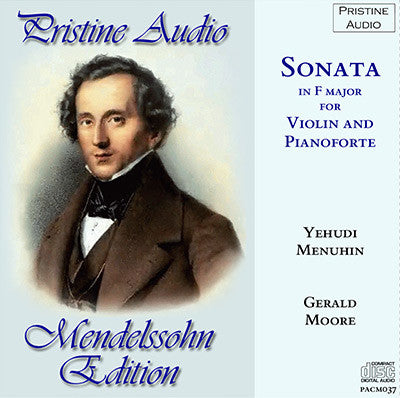
This album is included in the following sets:
This set contains the following albums:
- Producer's Note
- Full Track Listing
- Cover Art
Menuhin Plays Mendelssohn's Early Violin Sonata
Introduction: Felix Mendelssohn was born in Hamburg, Germany on 3rd February, 1809 into a distinguished and afflluent family of bankers, intellectuals and artists. A child prodigy, he produced his first composition in 1820; a constant stream of work continued throughout his relatively short life - he died in Leipzig on 4th November, 1847 at the age of just 38. These notes, which accompany Pristine Audio's Mendelssohn Edition, released to mark the 160th anniversary of his oratio Elijah, our first award-winning release for Divine Art, follow Mendelssohn's life through eight compositions newly remastered for August 2006.
"This work finished June 15, 1838... has never been published, and the original manuscript is the only source of the photostat copy which has come into my possession. This Sonata fills a great gap in violin literature as there is only one other work which Mendelssohn wrote for violin and piano - an earlier sonata in F minor."
- Yehudi Menuhin, 1952
In his statement, Menuhin does not
refer to a very early sonata, written before the age of 10; the early
sonata he does mention, Op. 4, was written in 1925 at the age of 16.
Thus here we have a highly important piece of music, written but not
published, and effectively lost for over 110 years. This is surprising -
in the opinion of biographer Philip Radcliffe, "The Sonata as a whole
is one of the best instrumental works of its period, and it is
surprising that its composer did not consider it worth of publication."
Mendelssohn
did write and publish a Cello Sonata in the same year (Op. 45), as well
as two string quartets (Op. 44) - clearly a good year for chamber
music. By this stage he was installed at Leipzig, having moved there in
1835 to take charge of the Gewandhaus Orchestra, championing both
historical and modern works - of the former he is particularly well
known for reviving interest in the music of Bach; in 1838 he was also
championing Naumann (1741-1801), Righini (1756-1812) and Vogler
(1696-1765), all of whom have once more been virtually forgotten. But
take a listen to the brilliant finale in the example given here - a
superb piece of writing which uses a constant interweaving of the two
parts to greater effect than many of his later finales in a similar vein
- and you will surely agree that this is one aspect of Mendelssohn's
work in 1838 that did not deserve to be forgotten.
Andrew Rose
MENDELSSOHN Violin Sonata in F major (1820)
Recorded 8 October 1952, Abbey Road Studio 3, London
Released as HMV ALP.1085
Duration 19:44
Yehudi Menuhin, violin
Gerald Moore, piano
Fanfare Review
...what is particularly remarkable is not that they are “timeless”
performances in the sense of being fine classical pieces, but that
Menuhin was as consistently interesting an artist at age 19 as he was at
age 36. The ecstatic opening lines of the violin in the Beethoven are
matched by the equally impassioned playing of the Mendelssohn, which in a
sense was a “world premiere.” Menuhin had been given a photostat copy
of the original manuscript, and no evidence has been found that this
sonata was ever played except perhaps by Mendelssohn and a friend (or
family member) the year it was written. Certainly, this was its world
premiere recording...
The Mendelssohn, aside from being an
excellent piece, also gives us a very rare glimpse of Gerald Moore as a
chamber-music partner. The famed accompanist was well known for his work
with singers, but seldom ventured into the realm of sonata work. This
is unfortunate. His playing here is exuberant, crystal-clear, and a good
foil for the violinist’s rhapsodic lyricism. Also, Moore’s penchants
for structural clarity and brisk tempos help move the music and keep it
from becoming languorous or thick. Menuhin, sadly, does have moments in
each performance where he goes a bit flat, but for most listeners this
is easy to overlook in the face of such artistry.
